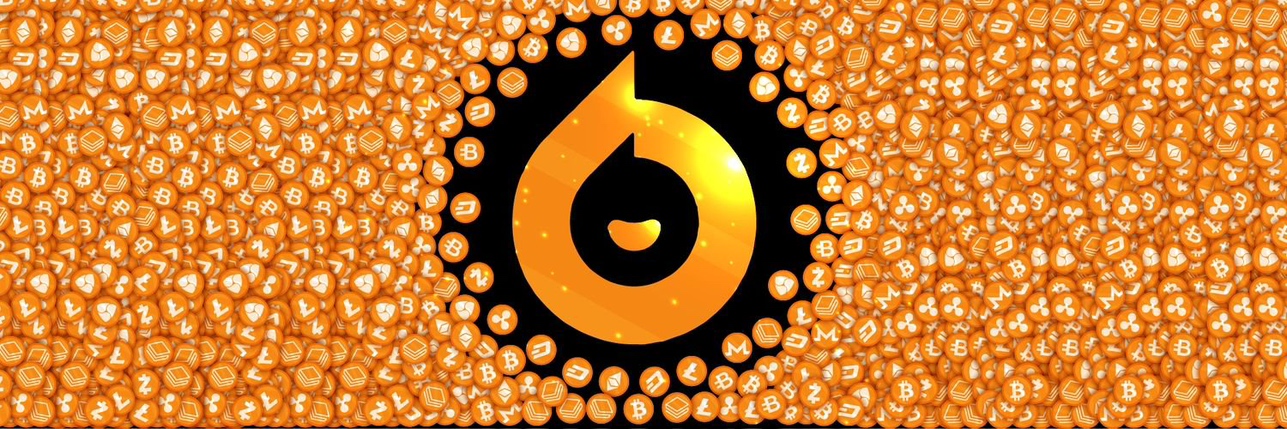Bitget: Auf Platz 4 im weltweiten täglichen Handelsvolumen!
BTC-Marktanteil63.33%
Neue Listings auf Bitget : Pi Network
BTC/USDT$94033.15 (+0.07%)Angst und Gier Index61(Gier)
Altcoin-Saison-Index:0(Bitcoin-Saison)
In Pre-Market gelistete CoinsSIGNGesamtnettozufluss des Bitcoin-ETF +$380M (1T); +$3.14B (7T).Willkommensgeschenkpaket für neue Nutzer im Wert von 6.200 USDT.Jetzt beanspruchen
Handeln Sie jederzeit und überall mit der Bitget-App. Jetzt herunterladen
Bitget: Auf Platz 4 im weltweiten täglichen Handelsvolumen!
BTC-Marktanteil63.33%
Neue Listings auf Bitget : Pi Network
BTC/USDT$94033.15 (+0.07%)Angst und Gier Index61(Gier)
Altcoin-Saison-Index:0(Bitcoin-Saison)
In Pre-Market gelistete CoinsSIGNGesamtnettozufluss des Bitcoin-ETF +$380M (1T); +$3.14B (7T).Willkommensgeschenkpaket für neue Nutzer im Wert von 6.200 USDT.Jetzt beanspruchen
Handeln Sie jederzeit und überall mit der Bitget-App. Jetzt herunterladen
Bitget: Auf Platz 4 im weltweiten täglichen Handelsvolumen!
BTC-Marktanteil63.33%
Neue Listings auf Bitget : Pi Network
BTC/USDT$94033.15 (+0.07%)Angst und Gier Index61(Gier)
Altcoin-Saison-Index:0(Bitcoin-Saison)
In Pre-Market gelistete CoinsSIGNGesamtnettozufluss des Bitcoin-ETF +$380M (1T); +$3.14B (7T).Willkommensgeschenkpaket für neue Nutzer im Wert von 6.200 USDT.Jetzt beanspruchen
Handeln Sie jederzeit und überall mit der Bitget-App. Jetzt herunterladen



SMART PreisSMART
Nicht gelistet
Quotierte Währung:
EUR
Die Daten werden von Drittanbietern bezogen. Diese Seite und die zur Verfügung gestellten Informationen befürworten keine bestimmte Kryptowährung. Möchten Sie mit gelisteten Coins traden? Hier klicken
€0.001296+6.29%1D
Preis-Chart
SMART Preis-Chart (SMART/EUR)
Zuletzt aktualisiert 2025-04-27 14:08:01(UTC+0)
Marktkapitalisierung:--
Vollständig verwässerte Marktkapitalisierung:--
24S-Volumen:€368,797.7
24S-Volumen / Marktkapitalisierung:0.00%
24S Hoch:€0.001299
24S Tief:€0.001198
Allzeithoch:€0.008822
Allzeittief:€0.0009149
Tokens im Umlauf:-- SMART
Gesamtangebot:
9,000,010,200,000SMART
Zirkulationsrate:0.00%
Max. Angebot:
--SMART
Preis in BTC:0.{7}1565 BTC
Preis in ETH:0.{6}8189 ETH
Preis bei BTC-Marktkapitalisierung:
--
Preis bei ETH-Marktkapitalisierung:
--
Verträge:--
Wie denken Sie heute über SMART?
Hinweis: Diese Information ist nur als Referenz gedacht.
AI-Analysebericht über SMART
Heutige Highlights des KryptomarktesBericht ansehen
Live SMART Preis heute in EUR
Der Live-Preis von SMART liegt heute bei €0.001296 EUR, mit einer aktuellen Marktkapitalisierung von €0.00. Der Preis von SMART ist in den letzten 24 Stunden um 6.29% gestiegen, und das 24-Stunden-Handelsvolumen beträgt €368,797.7. Der Umrechnungskurs SMART/EUR (SMART zu EUR) wird in Echtzeit aktualisiert.
SMART Preisverlauf (EUR)
Der Preis von SMART ist -46.99% über das letzte Jahr. Der höchste Preis von in EUR im letzten Jahr war €0.002991 und der niedrigste Preis von in EUR im letzten Jahr war €0.0009149.
ZeitPreisänderung (%) Niedrigster Preis
Niedrigster Preis Höchster Preis
Höchster Preis 
 Niedrigster Preis
Niedrigster Preis Höchster Preis
Höchster Preis 
24h+6.29%€0.001198€0.001299
7d-16.91%€0.001126€0.001482
30d-1.99%€0.0009149€0.002124
90d-42.66%€0.0009149€0.002438
1y-46.99%€0.0009149€0.002991
Allzeit-84.45%€0.0009149(2025-04-07, 20 Tag(e) her )€0.008822(2023-11-03, 1 Jahr(e) her )
Was ist der höchste Preis von SMART?
Das Allzeithoch (ATH) von SMART auf EUR war €0.008822 und wurde auf 2023-11-03 erfasst. Im Vergleich zu SMART ATH ist der aktuelle Preis von SMART um 85.31% gesunken.
Was ist der niedrigste Preis von SMART?
Das Allzeittief (ATL) von SMART auf EUR war €0.0009149 und wurde am 2025-04-07 erfasst. Im Vergleich zu SMART ATL ist der aktuelle Preis von SMART um 41.64% gestiegen.
SMART Preisvorhersage
Wann ist ein guter Zeitpunkt, um SMART zu kaufen? Sollte ich SMART jetzt kaufen oder verkaufen?
Bei der Entscheidung, ob Sie SMART kaufen oder verkaufen sollen, müssen Sie zunächst Ihre eigene Handelsstrategie berücksichtigen. Die Handelsaktivitäten von Langzeit- und Kurzzeit-Tradern werden ebenfalls unterschiedlich sein. Der Bitget SMART technische Analyse kann Ihnen eine Referenz fürs Traden bieten.
Gemäß der SMART 4S Technische Analyse ist das Trading-Signal Kauf.
Gemäß der SMART 1T Technische Analyse ist das Trading-Signal Kauf.
Gemäß der SMART 1W Technische Analyse ist das Trading-Signal Starker Verkauf.
Wie hoch wird der Preis von SMART in 2026 sein?
Auf Grundlage des Modells zur Vorhersage der vergangenen Kursentwicklung von SMART wird der Preis von SMART in 2026 voraussichtlich €0.001275 erreichen.
Wie hoch wird der Preis von SMART in 2031 sein?
In 2031 wird der Preis von SMART voraussichtlich um +10.00% steigen. Am Ende von 2031 wird der Preis von SMART voraussichtlich €0.003116 erreichen, mit einem kumulativen ROI von +150.47%.
FAQ
Wie hoch ist der aktuelle Preis von SMART?
Der Live-Kurs von SMART ist €0 pro (SMART/EUR) mit einer aktuellen Marktkapitalisierung von €0 EUR. Der Wert von SMART unterliegt aufgrund der kontinuierlichen 24/7-Aktivität auf dem Kryptomarkt häufigen Schwankungen. Der aktuelle Preis von SMART in Echtzeit und seine historischen Daten sind auf Bitget verfügbar.
Wie hoch ist das 24-Stunden-Trading-Volumen von SMART?
In den letzten 24 Stunden beträgt das Trading-Volumen von SMART €368,797.7.
Was ist das Allzeithoch von SMART?
Das Allzeithoch von SMART ist €0.008822. Dieses Allzeithoch ist der höchste Preis für SMART seit seiner Einführung.
Kann ich SMART auf Bitget kaufen?
Ja, SMART ist derzeit in der zentralen Börse von Bitget verfügbar. Ausführlichere Anweisungen finden Sie in unserem hilfreichen Wie man kauft Leitfaden.
Kann ich mit Investitionen in SMART ein regelmäßiges Einkommen erzielen?
Natürlich bietet Bitget einen strategische Trading-Plattform, mit intelligenten Trading-Bots, um Ihre Trades zu automatisieren und Gewinne zu erzielen.
Wo kann ich SMART mit der niedrigsten Gebühr kaufen?
Wir freuen uns, ankündigen zu können, dass strategische Trading-Plattform jetzt auf der Bitget-Börse verfügbar ist. Bitget bietet branchenführende Handelsgebühren und -tiefe, um profitable Investitionen für Trader zu gewährleisten.
SMART Bestände nach Konzentration
Whales
Investoren
Einzelhandel
SMART Adressen nach Haltezeit
Inhaber
Cruiser
Trader
Live coinInfo.name (12) Preis-Chart

Globale SMART Preise
Wie viel ist SMART im Moment in anderen Währungen wert? Zuletzt aktualisiert: 2025-04-27 14:08:01(UTC+0)
SMART zu MXN
Mexican Peso
Mex$0.03SMART zu GTQGuatemalan Quetzal
Q0.01SMART zu CLPChilean Peso
CLP$1.38SMART zu UGXUgandan Shilling
Sh5.4SMART zu HNLHonduran Lempira
L0.04SMART zu ZARSouth African Rand
R0.03SMART zu TNDTunisian Dinar
د.ت0SMART zu IQDIraqi Dinar
ع.د1.93SMART zu TWDNew Taiwan Dollar
NT$0.05SMART zu RSDSerbian Dinar
дин.0.15SMART zu DOPDominican Peso
RD$0.09SMART zu MYRMalaysian Ringgit
RM0.01SMART zu GELGeorgian Lari
₾0SMART zu UYUUruguayan Peso
$0.06SMART zu MADMoroccan Dirham
د.م.0.01SMART zu OMROmani Rial
ر.ع.0SMART zu AZNAzerbaijani Manat
₼0SMART zu SEKSwedish Krona
kr0.01SMART zu KESKenyan Shilling
Sh0.19SMART zu UAHUkrainian Hryvnia
₴0.06- 1
- 2
- 3
- 4
- 5
Neue Listings auf Bitget
Neue Listings
Mehr kaufen
Wo kann ich Krypto kaufen?
Krypto mit der Bitget-App kaufen
Melden Sie sich innerhalb weniger Minuten an, um Kryptowährungen per Kreditkarte oder Banküberweisung zu kaufen.
Videobereich - schnelle Verifizierung, schnelles Trading

Wie Sie die Identitätsverifizierung auf Bitget durchführen und sich vor Betrug schützen
1. Loggen Sie sich bei Ihrem Bitget-Konto ein.
2. Wenn Sie neu bei Bitget sind, schauen Sie sich unser Tutorial an, wie Sie ein Konto erstellen.
3. Bewegen Sie den Mauszeiger über Ihr Profilsymbol, klicken Sie auf "Unverifiziert" und dann auf "Verifizieren".
4. Wählen Sie Ihr Ausstellungsland oder Ihre Region und den Ausweistyp und folgen Sie den Anweisungen.
5. Wählen Sie je nach Präferenz "Mobile Verifizierung" oder "PC".
6. Geben Sie Ihre Daten ein, legen Sie eine Kopie Ihres Ausweises vor und machen Sie ein Selfie.
7. Reichen Sie Ihren Antrag ein, und voilà, Sie haben die Identitätsverifizierung abgeschlossen!
Kryptowährungs-Investitionen, einschließlich des Kaufs von SMART online über Bitget, unterliegen dem Marktrisiko. Bitget bietet Ihnen einfache und bequeme Möglichkeiten, SMART zu kaufen, und wir versuchen unser Bestes, um unsere Nutzer über jede Kryptowährung, die wir auf der Börse anbieten, umfassend zu informieren. Wir sind jedoch nicht verantwortlich für die Ergebnisse, die sich aus Ihrem SMART Kauf ergeben können. Diese Seite und alle darin enthaltenen Informationen sind keine Empfehlung für eine bestimmte Kryptowährung.
DPoSSmart Contracts
SMART Bewertungen
Durchschnittliche Bewertungen in der Community
4.4
Dieser Inhalt dient nur zu Informationszwecken.
Bitget Insights

LeoWeb3
11S
In Web3, skills are your superpower.
Learn fast. Build smart. Own your future

CryptoPotato
16S
Ethereum Price Analysis: What’s Next for ETH After Surge to $1.8K Resistance?
Ethereum faced a notable increase in buying pressure, leading to a bullish rebound at the crucial $1.5K support. The price faces a decisive resistance range at $1.8K, expected to enter a short-term consolidation before breaking above it.
By Shayan
After a period of muted price action and market inactivity around the decisive $1.5K long-term support region, Ethereum eventually experienced a surge in buying pressure, triggering a bullish rebound. This wave of demand has pushed the price toward the significant $1.8K resistance zone. This area coincides with an important order block, where smart money typically places orders, reinforcing its significance.
The price action at this level is critical; a successful breakout above $1.8K would likely confirm a bullish reversal scenario, opening the path toward the $2.1K target. However, short-term consolidation around this resistance is probable before a decisive move unfolds.
On the lower timeframe, ETH’s previous tight-range consolidation was broken by a notable influx of buyers, resulting in an impulsive breakout above the descending channel. This breakout was accompanied by strong bullish momentum, driving the price toward the key $1.8K resistance zone.
This region aligns with Ethereum’s prior swing lows, making it a robust supply area. As a result, short-term consolidation is expected at this level until demand or supply pressure determines the next move. A bullish breakout above $1.8K would set the $2.1K range as the next likely target for buyers.
By Shayan
The funding rates metric is a crucial indicator of sentiment in the futures markets. Analysing its recent behaviour provides important insights into Ethereum’s latest surge. Typically, healthy and sustainable bullish trends are accompanied by rising funding rates, signalling an influx of buyers in both the perpetual futures and spot markets.
Currently, however, funding rates are consolidating and showing no significant increase. This suggests that Ethereum’s recent price surge has primarily been driven by spot market buying rather than futures market speculation. For this bullish trend to be validated and gain persistence, the funding rates metric needs to start rising, reflecting growing confidence and aggressive buying in the futures market as well.
ORDER-4.75%
ETH-1.30%

Crypto_Master_786
17S
#CryptoUpdate
Patience is about to be massively rewarded.
• $BTC squeezing in a tight range
• Altcoins showing hidden strength
• Narratives like AI ($FET) and Solana L2s ($TNSR, $W) building quietly
The crowd will chase later.
The smart ones are positioning now.
In crypto,
BTC-0.63%
FET-3.46%

Crypto_Master_786
1T
#CryptoAlpha
Altcoins are loading quietly while the crowd sleeps.
• $BTC dominance topping out
• $ETH heating up
• Hidden gems ($TNSR, $W, $PYTH, $ACE) showing smart money flows
This is the perfect storm setup:
• Boring price action
• Rising hidden volume
• Narratives
BTC-0.63%
ETH-1.30%

Bpay-News
1T
Bitget Onchain launches LetsBONK, Hosico, MCP and other tokens
Bitget Onchain has launched Solana ecosystem’s MEME tokens LetsBONK, Hosico, MCP, CFX, ZALA, UPONLY, and Wilma. Users can start trading in the on-chain trading section. Bitget Onchain aims to seamlessly connect CEX and DEX, providing users with a more convenient, efficient, and secure on-chain trading experience. Users can directly use the spot account (USDT/USDC) in the Bitget App to trade popular assets on the chain. Currently, popular public chains such as Solana (SOL), BNB Smart Chain (BSC), and Base are supported.
USDC0.00%
BNB-1.16%
Verwandte Assets
Beliebte Kryptowährungen
Eine Auswahl der 8 wichtigsten Kryptowährungen nach Marktkapitalisierung.
Kürzlich hinzugefügt
Die zuletzt hinzugefügten Kryptowährungen.
Vergleichbare Marktkapitalisierung
Von allen Bitget-Assets sind diese 8 in Bezug auf die Marktkapitalisierung am nächsten an SMART dran.
Zusätzliche Informationen über SMART
Coin-Übersicht
Coin bezogen
Trading bezogen






























